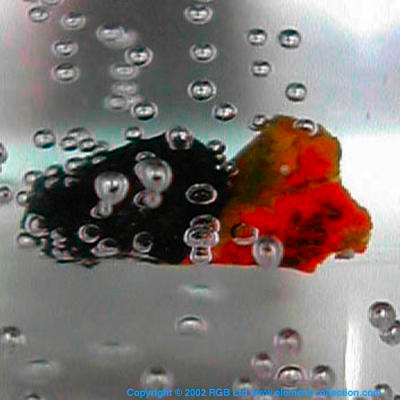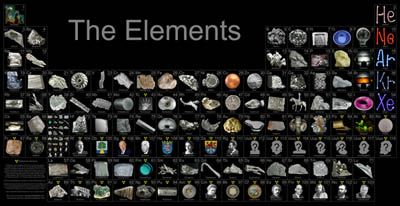|
|
|
|
|
|
|
|
|
|
|
|
|
|
|
|
Radon gas is radioactive, and it seeps out of the ground all over the world (more in some places than others), collecting in basements and causing lung cancer. It is generated by the radioactive decay of thorium, of which there is a lot in the earth's crust. You can install special fans and venting systems to remove the radon from your house, which may be a good idea if the levels in your geographical area are unusually high.
There was a brief period of time in the early twentieth century during which people thought radon was a good thing, and actually bought products to introduce it into their drinking water. I have an example listed under uranium. (They were wrong.)
|
|
| |
|
|
|
|
|
Radon generating thorium oxide.
The longest-lived isotope of radon has a half-life of only 3.8 days, which means you can't really collect and store a sample of radon: It would be completely gone within a few weeks. But you can seal up some thorium oxide in a glass tube and be sure you always have some. Radon is one of the decay products of thorium, and there will always be some radon gas trapped in the tube. The concentration should be fairly constant, because thorium has a very long half-life while radon has a very short one: There should by now exist in this tube an equilibrium concentration of radon, which perhaps some helpful reader will calculate for me (necessary information: ca. 0.5g of thorium oxide in ca. 0.5cc volume tube).
The source of this tube, Gillian Pearce, reports that thorium oxide is a better source of radon than is pure thorium metal (which I have much more of), because the radon can't escape from the metal and remains trapped there as it decays.
Mike Seifert, a graduate student in Physics at the University of Chicago, wrote to me with a calculation of how much radon he thinks is in my tube: Since you asked on your radon page: by my calculations, you have about 5.2 * 10^-17 grams of radon in your tube of thorium oxide. The source of this number is essentially (after a moderate amount of math):
mass of radon = (Rn half-life)/(Th half-life) * (Rn_220 AW) / (Th O_2 MW) * mass of Th O_2
Since the radon-220 lifetime is about 56 seconds while that of thorium-232 is about 1.4 billion years, there really ain't much radon in there... Another way to think about it is that the partial pressure of the radon in the tube is about 1.2 * 10^-6 Pascals, or about 9 * 10^-9 torr. Still better than outer space by about two or three orders of magnitude, though. Ah well, it's the thought that counts. :-)
Source: eBay seller rubbleshop
Contributor: eBay seller rubbleshop
Acquired: 19 October, 2002
Price: Donated
Size: 1"
Purity: <1%
|
|
|
|
|
|
|
Sample from the RGB Set.
The Red Green and Blue company in England sells a very nice element collection in several versions. Max Whitby, the director of the company, very kindly donated a complete set to the periodic table table.
To learn more about the set you can visit my page about element collecting for a general description or the company's website which includes many photographs and pricing details. I have two photographs of each sample from the set: One taken by me and one from the company. You can see photographs of all the samples displayed in a periodic table format: my pictures or their pictures. Or you can see both side-by-side with bigger pictures in numerical order.
The picture on the left was taken by me. Here is the company's version (there is some variation between sets, so the pictures sometimes show different variations of the samples):

Source: Max Whitby of RGB
Contributor: Max Whitby of RGB
Acquired: 25 January, 2003
Text Updated: 11 August, 2007
Price: Donated
Size: 0.2"
Purity: <2%
|
|
|
|
|
|
|
Sample from the Everest Set.
Up until the early 1990's a company in Russia sold a periodic table collection with element samples. At some point their American distributor sold off the remaining stock to a man who is now selling them on eBay. The samples (except gases) weigh about 0.25 grams each, and the whole set comes in a very nice wooden box with a printed periodic table in the lid.
Radioactive elements like this one are represented in this particular set by a non-radioactive dummy powder, which doesn't look anything like the real element. (In this case a sample of the pure element isn't really practical anyway.)
To learn more about the set you can visit my page about element collecting for a general description and information about how to buy one, or you can see photographs of all the samples from the set displayed on my website in a periodic table layout or with bigger pictures in numerical order.
Source: Rob Accurso
Contributor: Rob Accurso
Acquired: 7 February, 2003
Text Updated: 18 January, 2009
Price: Donated
Size: 0.2"
Purity: 0%
|
|
|
|
|
|
|
  Granite sphere. Granite sphere.
Radon is a hard element to pin down: You can't see it because it's a clear gas, and you can't even have a vial of it because it's extremely radioactive and has a half life of only 3.2 days. One place it can be found, if only in microscopic and invisible quantities, is in granite rocks. Granite contains uranium and thorium impurities, which constantly give off small amounts of radon gas. This is why areas of the country with certain kinds of bedrock also have problems with radon collecting in basements. And it's why large granite buildings are measurably more radioactive than normal.
I chose this sample to represent its element in my Photographic Periodic Table Poster. The sample photograph includes text exactly as it appears in the poster, which you are encouraged to buy a copy of.

Source: Kinetic Fountains
Contributor: Theodore Gray
Acquired: 10 August, 2005
Text Updated: 4 May, 2007
Price: $120
Size: 10"
Purity: 0.00001%
|
|
|
|
|
|
|
|
|
|
Single-use radon gas detector.
Small vial you put in your basement for a couple of days, then mail in to a lab for testing, to see how much radon you've got.
Source: Hardware Store
Contributor: Theodore Gray
Acquired: 29 April, 2009
Text Updated: 30 April, 2009
Price: $10
Size: 2"
Purity: 0%
|
|
|
|
|
|
|
Electronic radon gas detector.
Continuous electronic radon gas monitor that reads out in Pico-curies per liter. You can choose between averaging over a few days, or over the whole time the monitor has been installed.
Source: Catalog
Contributor: Theodore Gray
Acquired: 29 April, 2009
Text Updated: 28 June, 2009
Price: $120
Size: 5"
Purity: 0%
|
|
|
|
|
|
|
|
|
|
|
|
|
|
|